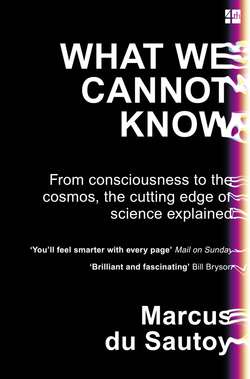Читать книгу What We Cannot Know: Explorations at the Edge of Knowledge - Marcus Sautoy du - Страница 46
THE HARMONY OF TINY SPHERES
ОглавлениеWith the insights of the science of Newton’s generation and beyond, the tide would turn in favour of the view that the universe is indeed made from basic building blocks. Newton’s contemporary, Robert Boyle, was perhaps the first to question the Aristotelian view of matter, which had dominated for nearly 2000 years. In his book The Sceptical Chymist, Boyle challenged the idea that matter was made up of the four elements of fire, earth, air and water. These might be good descriptions of the states of matter but not of the constituents.
Instead, he argued for a new list of chemical elements. Not only that, he made what at the time was rather a heretical statement. He believed that these elements would be minute bodies or atoms differing only in ‘bulk, figure, texture and motion’. This was regarded as theologically dangerous: a materialistic godless view of the world in the eyes of the Church, which had always favoured the Aristotelian view. Some have declared Boyle the Galileo of the chemical revolution.
Although Newton would concur with Boyle’s proposal for a material world made from indivisible units, the mathematical tools that Newton developed at the same time as Boyle’s work relied heavily on time and space being infinitely divisible. The calculus that allowed one to take a snapshot of a universe in constant flux made sense only as a process in which space is divided up into ever smaller pieces and then interpreting what happens in the limit as the pieces become infinitesimally small.
The question of the infinite divisibility of time and space had fuelled philosophical argument since the ancient Greek thinker Zeno of Elea came up with paradoxes that seemed to arise from this cutting up of space. For example, Zeno proposed that an arrow can never hit its target because it must first cover half the distance to the target, then half the distance again, and then half again, requiring infinitely many moves if it is ever going to make it to the target. The success of Newton’s calculus reignited the debate. There were still those who considered such infinite divisibility as almost heretical.
Bishop Berkeley dedicated a whole treatise called The Analyst to arguing that trying to make sense of dividing by zero was absurd, which the subtitle made clear: it was ‘Addressed to an Infidel MATHEMATICIAN’.
While most infidel mathematicians quickly latched on to the power of the calculus, Newton’s other breakthroughs supported a view that, although space and time could be infinitely divided, matter could not. His idea of a world made up of indivisible matter would in time become the prevalent theory of the universe. But at this point it was still very much a theory without a great deal of evidence.
His theory of forces acting on large objects like planets and apples had been so successful that Newton believed that if the ideas worked on the very large and the medium sized then why not on the very small. Why should there be a change in the way the laws of motion dictate the behaviour of the universe as we zoom in on my dice? The success of his calculus when applied to the movement of the planets depended on regarding them as single points with the mass concentrated at a point corresponding to the centre of gravity of the body. Maybe all matter consisted of particles like tiny planets whose behaviour was determined by his laws of motion. In his Principia he stated his belief that by applying his ideas to these individual particles one could predict the behaviour of all material things.
Newton’s theory of light also contributed to the growing feeling that an atomistic perspective was the best way to understand the world. Regarding light as a particle seemed the easiest way to describe the phenomena he documented in his book Opticks. The way that light reflected seemed to mimic the behaviour of a billiard ball as it bounced off the sides of the table. But from a scientific point of view there was no empirical evidence for this model of a universe made from indivisible particles.
Even with the microscopes that were emerging in the seventeenth century, you couldn’t see anything to justify this atomistic model. Even if you could see discrete objects, it wouldn’t prove anything about their indivisibility. But we can judge that the tide was turning by the fact that the atomistic view of matter made it into the popular culture of the time. Nicholas Brady’s ‘Ode to Saint Cecilia’, set to music by Purcell in 1691, talks of seeds of matter:
Soul of the World! Inspir’d by thee,
The jarring Seeds of Matter did agree,
Thou didst the scatter’d Atoms bind,
Which, by thy Laws of true proportion join’d,
Made up of various Parts one perfect Harmony.
The best evidence for an atomistic view of matter came a hundred years later from experiments that showed how matter combined to make new materials. And it was full of perfect harmony, as Brady had intimated.
